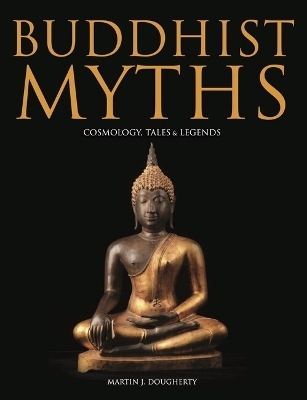
Buddhist Myths
Amber Books (Verlag)
978-1-83886-226-8 (ISBN)
Practiced today by more than 500 million adherents, Buddhism emerged from India between the sixth and fourth centuries BCE. Based around the original teachings of the Buddha, key texts emerged to promote a true understanding of Buddhist ethics and spiritual practices.
The Buddhist traditions created a vast body of mythological literature, much of it focused on the life of the Buddha. For example, the 550 Jataka Tales tell of Buddha’s early life and renunciation, as well as his previous human and animal incarnations. The stories also tell of Gautama Buddha’s family, such as his mother Mara, and her dream of a white elephant preceding his birth; as well as his cousin, Devadatta, a disciple monk who rebelled against Buddha and tried to kill him. Buddhist literature includes numerous parables – such as the Turtle Who Couldn’t Stop Talking – as well as recounting scenes from the Indian epic the Ramayana. History and myth intermingle in texts such as Ashokavadana, where the Mauryan emperor Ashoka is portrayed as a model of Buddhist kingship.
Illustrated with 120 photographs and artworks, Buddhist Myths is an accessible, engaging and highly informative exploration of the fascinating mythology underlying one of the world’s oldest and most influential religions.
Martin J. Dougherty is a freelance writer specializing in military and defence topics. He is the author of Medieval Warrior, SAS and Elite Forces Guide Extreme Unarmed Combat, and SAS and Elite Forces Guide Sniper, Small Arms: From the Civil War to the Present Day, and books on personal self-defence. He lives in northern England.
Contents include:
Introduction
The birth and spread of Buddhism from its origins in northern India in the sixth century BCE.
1. Concepts and Cosmology
Spatial cosmology: Formless Realm; Form Realm; Desire Realm; Sahasra cosmology. The Four Great Elements; the Seven Ranges; Great Outer Ocean; the Great Lakes; the Great Trees; Kamavacara (plane of sense desire); Manussaloka (the human realm); the Animal realm; the Lower realm
Temporal cosmology: Vivatakalpa; Vivartasthayikalpa; Samvartakalpa; Samvartasthayikalpa.
2. Life of the Buddha
The life of the Buddha is described in a number of sacred texts, including the Buddhacarita, Lalitavistara Sūtra, Mahāvastu, and the Nidānakathā. Other texts include: the Mūlasarvāstivāda Vinaya, the Abhiniṣkramana Sūtra and the Theravada. Typical motifs: The Buddha’s mother, Māyā, dreaming of a white elephant; lotuses springing up under the feet of the bodhisattva as he walked immediately after birth; seeing the four signs; the bodhisattva leaving his wife and child, often on the night of the birth; the bodhisattva's horse, Kaṇṭhaka, who carried him away, but later died of grief; the offering of milk rice by Sujātā; the attack by Māra’s armies.
3. The Jataka Tales
A part of the Pali Canon, the 550 Jataka Tales are a huge body of work outlining the previous births of Gautama Buddha in both human and animal form. Often, Jātaka stories include an extensive cast of characters who interact and get into various kinds of trouble – whereupon the Buddha character intervenes to bring about a resolution. Includes the story of Rama (Ramayana) in the Dasaratha Jataka.
4. Teachings of the Buddha
The Pali Canon: The Tripitaka and the Sutras. Sutras are aphorisms and stories designed to demonstrate some part of Buddhist doctrine.
Sutta Pitaka: discourses and sermons of Buddha.
Mahayana sutras: such as the Lotus sutra and the Avatamsaka Sutra contain popular stories and parables that have been widely influential in Mahayana Buddhism.
Ten Principal Disciples (Mahayana tradition) Kangyur: holy Tibetan scripts
5: Divine and Extraordinary Beings
Buddhism includes a wide array of divine beings that are venerated in various ritual and popular contexts. Key figures: Bodhisattvas; Yidam, or Ishta-devata (personal meditation deity); Devas; Asuras; Maras; Yakshas; Kinnaras; Nagas.
Goddesses include: Prthivi – Mother Earth; Sri Lakshmi – goddess of good fortune; Hariti – goddess of motherly love. Mahayana goddesses: Prajnaparamita – mother of perfect wisdom; Marici – lady of sunrise; Cunda – saving grace; Tara – universal saviour; Tantric female Buddhas
6: Notable Figures
Indian kings feature in many Buddhist stories and myths. The earliest texts speak of various kings paying respects to the Buddha. The Buddhist myths which developed around the famed Mauryan emperor Ashoka are also important sources of Buddhist mythology. These stories serve as morality tales and as models for Buddhist kingship, which were emulated and used by later Buddhist monarchies throughout the Buddhist world.
Glossary
Index
| Erscheinungsdatum | 17.10.2022 |
|---|---|
| Reihe/Serie | Myths & Legends |
| Zusatzinfo | Index; Maps; Halftones, color; Halftones, black and white; Illustrations, color |
| Sprache | englisch |
| Maße | 192 x 250 mm |
| Gewicht | 890 g |
| Themenwelt | Geschichte ► Allgemeine Geschichte ► Altertum / Antike |
| Geisteswissenschaften ► Religion / Theologie ► Weitere Religionen | |
| Sozialwissenschaften ► Soziologie | |
| ISBN-10 | 1-83886-226-9 / 1838862269 |
| ISBN-13 | 978-1-83886-226-8 / 9781838862268 |
| Zustand | Neuware |
| Haben Sie eine Frage zum Produkt? |
aus dem Bereich


